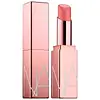What's inside
What's inside
 Key Ingredients
Key Ingredients

 Benefits
Benefits

 Concerns
Concerns

 Ingredients Side-by-side
Ingredients Side-by-side

Diisostearyl Malate
EmollientBis-Behenyl/Isostearyl/Phytosteryl Dimer Dilinoleyl Dimer Dilinoleate
EmollientPolyglyceryl-2 Triisostearate
EmulsifyingBis-Diglyceryl Polyacyladipate-2
EmollientParaffin
PerfumingTridecyl Trimellitate
EmollientPentaerythrityl Tetraisostearate
EmollientMicrocrystalline Wax
Emulsion StabilisingSorbitan Isostearate
Emulsifying1,2-Hexanediol
Skin ConditioningDisteardimonium Hectorite
StabilisingSynthetic Wax
AbrasiveCI 77891
Cosmetic ColorantEthylene/Propylene Copolymer
AbrasiveCI 45410
Cosmetic ColorantCI 15985
Cosmetic ColorantPropylene Carbonate
SolventCI 15850
Cosmetic ColorantParfum
MaskingLimonene
PerfumingLinalool
PerfumingSimmondsia Chinensis Seed Oil
EmollientPrunus Amygdalus Dulcis Oil
Skin ConditioningPrunus Armeniaca Kernel Oil
MaskingOenothera Biennis Oil
EmollientOlea Europaea Fruit Oil
MaskingArgania Spinosa Kernel Oil
EmollientButyrospermum Parkii Butter
Skin ConditioningCamellia Japonica Seed Oil
EmollientCaprylic/Capric Triglyceride
MaskingMangifera Indica Fruit Extract
Skin ConditioningRosa Canina Fruit Extract
AstringentDiisostearyl Malate, Bis-Behenyl/Isostearyl/Phytosteryl Dimer Dilinoleyl Dimer Dilinoleate, Polyglyceryl-2 Triisostearate, Bis-Diglyceryl Polyacyladipate-2, Paraffin, Tridecyl Trimellitate, Pentaerythrityl Tetraisostearate, Microcrystalline Wax, Sorbitan Isostearate, 1,2-Hexanediol, Disteardimonium Hectorite, Synthetic Wax, CI 77891, Ethylene/Propylene Copolymer, CI 45410, CI 15985, Propylene Carbonate, CI 15850, Parfum, Limonene, Linalool, Simmondsia Chinensis Seed Oil, Prunus Amygdalus Dulcis Oil, Prunus Armeniaca Kernel Oil, Oenothera Biennis Oil, Olea Europaea Fruit Oil, Argania Spinosa Kernel Oil, Butyrospermum Parkii Butter, Camellia Japonica Seed Oil, Caprylic/Capric Triglyceride, Mangifera Indica Fruit Extract, Rosa Canina Fruit Extract
Hydrogenated Polyisobutene
EmollientTriisostearin
Skin ConditioningSqualane
EmollientBis-Diglyceryl Polyacyladipate-2
EmollientDiphenylsiloxy Phenyl Trimethicone
Skin ConditioningPolyethylene
AbrasiveEthylhexyl Methoxycinnamate
UV AbsorberMicrocrystalline Wax
Emulsion StabilisingDiisostearyl Malate
EmollientCocos Nucifera Oil
MaskingGardenia Taitensis Flower Extract
Skin ConditioningTocopheryl Acetate
AntioxidantSimmondsia Chinensis Seed Oil
EmollientPunica Granatum Flower Extract
Skin ConditioningTocopherol
AntioxidantGlyceryl Diisostearate
EmollientSimethicone
EmollientTrimethylolpropane Triethylhexanoate
EmollientLauryl PCA
HumectantBHT
AntioxidantSilica
AbrasiveAluminum Hydroxide
EmollientPolysilicone-2
Tin Oxide
AbrasivePhenoxyethanol
PreservativeCI 75470
Cosmetic ColorantCI 77491
Cosmetic ColorantCI 77492
Cosmetic ColorantCI 77499
Cosmetic ColorantMica
Cosmetic ColorantCI 45410
Cosmetic ColorantCI 15850
Cosmetic ColorantCI 77891
Cosmetic ColorantHydrogenated Polyisobutene, Triisostearin, Squalane, Bis-Diglyceryl Polyacyladipate-2, Diphenylsiloxy Phenyl Trimethicone, Polyethylene, Ethylhexyl Methoxycinnamate, Microcrystalline Wax, Diisostearyl Malate, Cocos Nucifera Oil, Gardenia Taitensis Flower Extract, Tocopheryl Acetate, Simmondsia Chinensis Seed Oil, Punica Granatum Flower Extract, Tocopherol, Glyceryl Diisostearate, Simethicone, Trimethylolpropane Triethylhexanoate, Lauryl PCA, BHT, Silica, Aluminum Hydroxide, Polysilicone-2, Tin Oxide, Phenoxyethanol, CI 75470, CI 77491, CI 77492, CI 77499, Mica, CI 45410, CI 15850, CI 77891
 Reviews
Reviews

Ingredients Explained
These ingredients are found in both products.
Ingredients higher up in an ingredient list are typically present in a larger amount.
This ingredient is lipid-based synthetic skin-conditioning agent derived from adipic acid and a mixture of fatty acids. It is often called a lanolin substitute.
As an emollient, it helps soften and hydrate the skin. Emollients create a barrier on the skin to trap moisture in.
Due to its fatty acid base, it may not be Malassezia folliculitis safe.
Learn more about Bis-Diglyceryl Polyacyladipate-2Ci 15850 is the pigment color red. It is an azo dye and created synthetically.
Azo dyes need to be thoroughly purified before use. This allows them to be more stable and longer-lasting.
This ingredient is common in foundations, lipsticks, and blushes. This color is described as brown/orangey red.
It has many secondary names such as Red 6 and Red 7. According to a manufacturer, Red 6 usually contains aluminum.
Learn more about CI 15850CI 45410 is a synthetic red-pigment and dye.
It often goes by both Red 28 or Red 27; manufacturers label both ingredients as CI 45410.
This dye is commonly found in makeup because it imparts a vivid color. Some types of this dye change color based on pH level and interaction with moisture:
Your skin has a natural pH of around 4.5 - 5.5.
According to the FDA, CI 45410 is not permitted for use in eye products.
Red 27 is a flourescein dye and commonly used as a fluorescent tracer in medicine.
Learn more about CI 45410Ci 77891 is a white pigment from Titanium dioxide. It is naturally found in minerals such as rutile and ilmenite.
It's main function is to add a white color to cosmetics. It can also be mixed with other colors to create different shades.
Ci 77891 is commonly found in sunscreens due to its ability to block UV rays.
Learn more about CI 77891Diisostearyl Malate is an emollient and most often used in lip products. It comes from isostearyl alcohol, a fatty acid, and malic acid, an AHA.
As an emollient, Diisostearyl Malate helps create a thin film on your skin to trap moisture in. This helps keep your skin soft and smooth.
Microcrystalline Wax is created by de-oiling petroleum. It is highly refined and purified before being added to cosmetics.
Microcrystalline Wax is used to enhance the texture and create even consistency. It helps stabilize a product by preventing ingredients from separating.
This oil comes from the seeds of the desert shrub called Jojoba. It is more commonly known as jojoba oil, a non-comedogenic oil.
Jojoba oil does not contain fragrance and has many fatty-acids, making it a great soothing ingredient.
It also contains Vitamin E, a great moisturizing ingredient. Vitamin E is also an antioxidant and protects your skin against oxidative damage.
This ingredient humectant properties, meaning it helps draw moisture from the air. This helps keep your skin hydrated.
While jojoba has antibacterial properties, it is only able to kill some strains of bacteria.
Studies also show it helps in wound healing. In fact, Indigenous cultures have used jojoba as a moisturizer and to help treat burns for centuries.
Fun fact: Jojoba oil similar to natural human skin sebum, so it has a great effect on dry skin. It is also promising with helping to regulate sebum production.
Due to its fatty acid content, Jojoba oil may not be fungal acne safe. We recommend speaking with a professional if you have any concerns.
Learn more about Simmondsia Chinensis Seed Oil